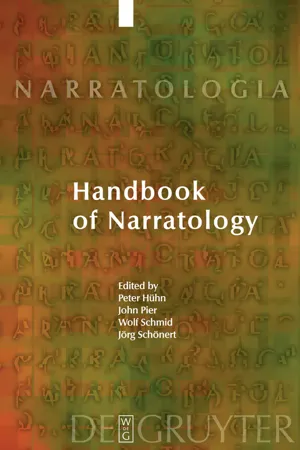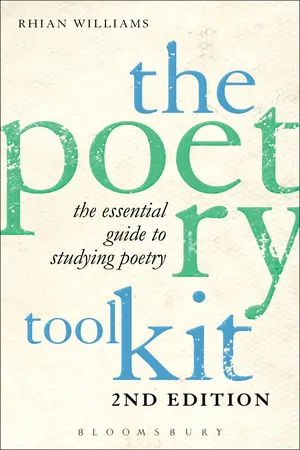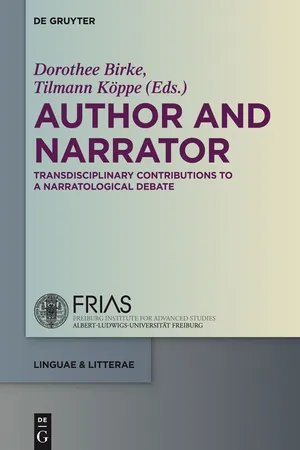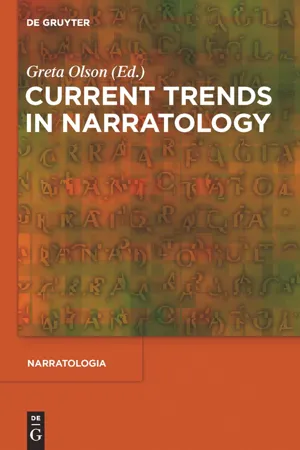Literature
Narrative Poetry
Narrative poetry is a form of poetry that tells a story through verse. It often includes characters, a plot, and a setting, and can range from epic poems to ballads. Narrative poems use poetic devices and language to create a vivid and engaging storytelling experience for the reader.
Written by Perlego with AI-assistance
Related key terms
1 of 5
7 Key excerpts on "Narrative Poetry"
- eBook - PDF
- Peter Hühn, John Pier, Wolf Schmid, Jörg Schönert, Peter Hühn, John Pier, Wolf Schmid, Jörg Schönert(Authors)
- 2009(Publication Date)
- De Gruyter(Publisher)
Narration in Poetry and Drama Peter Hühn & Roy Sommer 1 Definition Narration as a communicative act in which a chain of happenings is meaningfully structured and transmitted in a particular medium and from a particular point of view underlies not only narrative fiction proper but also poems and plays in that they, too, represent temporally organized sequences and thus relate “stories,” albeit with certain genre-specific differences, necessarily mediating them in the manner of pres-entation. Lyric poetry in the strict sense (and not only obviously narra-tive poetry like ballads or verse romances) typically features strings of primarily mental or psychological happenings perceived through the consciousness of single speakers and articulated from their position. Drama enacts strings of happenings with actors in live performance, the presentation of which, though typically devoid of any overt present-ing agency, is mediated e.g. through selection, segmentation and ar-rangement. Thanks to these features characteristic of narra-tive, lyric poems as well as plays performed on the stage can be profitably an-alyzed with the transgeneric application of narratological categories, though with poetry the applicability of the notion of story and with drama that of mediation seems to be in question. 2 Explication Transgeneric narratology proceeds from the assumption that narra-tology’s highly differentiated system of categories can be applied to the analysis of both poems and plays, possibly opening the way to a more precise definition of their respective generic specificity, even though (lyric) poems do not seem to tell stories and stories in dramas do not seem to be mediated (but presented directly). As far as poetry is con-cerned, the following argument concentrates on lyric poetry in the nar-row sense: that narratological categories are generally applicable to narrative verse is obvious. - eBook - PDF
- Rhian Williams(Author)
- 2013(Publication Date)
- Bloomsbury Academic(Publisher)
In the first instance, it is useful to identify whether a poem is telling a story, expressing an emotion, presenting an action, or whatever. Clarifying that point can free us up to experience that poem clearly. Of course, many poems do all these things and more at the same time, but the conventions to which a poem alludes can help us identify which, if any, of these dominate. The traditions considered here have been particularly significant for poetic production in English – of course, in prose and drama other conventions also exist – and they generally fall into narrative traditions and expressive traditions. Narrative Poetry is primarily concerned to present a story of any kind: those included here are epic, ballad, romance and, loosely, blank verse (considered in the chapter on form). Expressive poetry relies less on the passing of time and more on the experience of emotion and thoughtfulness: examples included here are lyric, elegy, some love poetry, and pastoral. Yet all of these categories infuse each other constantly: stories are told with emotion and emotions take place over time. It is perhaps more useful to think in terms of stylistic traditions or modes of telling stories and expressing emotions: some are told with particular solemnity, some with lightheartedness and comedy. During this discussion various topoi (singular topos ) and motifs will become apparent. Topos means ‘a place’; however, it has come to indicate a recurrent formulation or concept – a commonplace in fact – in a literary work (such as the notion that a hero is physically strong, for example). A motif is a dominant emblem that also recurs throughout a literary work, becoming a symbol of the work’s central idea (it might be a physical motif, such as a sword or a gem, or an emotional motif, such as longing, or nostalgia). - eBook - ePub
Author and Narrator
Transdisciplinary Contributions to a Narratological Debate
- Dorothee Birke, Tilmann Köppe, Dorothee Birke, Tilmann Köppe(Authors)
- 2015(Publication Date)
- De Gruyter(Publisher)
505In summary, as not all forms of ‘lyric poetry’ are covered by a narratological frame such as that provided by Hühn and Schönert, a genre theorist may still insist that this does not amount to a comprehensive definition of ‘lyric poetry’.506 Moreover, even if it can be shown that most lyric poems tell a story,507 it does not follow that this has to be the basis of a definition of the genre of ‘poetry’ or even ‘lyric poetry’. For it may be that there are other features of this group of literary texts apart from the criterion of narrative concatenation that might serve just as well (or even better) as a starting point for a fruitful definition.508Apart from that, though, as it is highly likely that most lyric poems can be classified as narrative at least in a minimal sense, a narratological approach to the study of ‘lyric poetry’ proves to be fruitful when perceived as providing another analytic tool box for the study of lyric poetry besides the ones provided by rhetorical and metrical analysis.509III Conclusion
Despite these advantages of the narratological approach, the author-narrator distinction adopted from classical narratology is only of limited help in the study of lyric poetry: it neither fulfils all requirements for a proper theory of fiction nor depicts all possible sources of utterance of poetry and the complex interrelations between them. Furthermore, it seems implausible to assume that all lyric poems feature a narrative structure, and it is by no means true that all narrative lyric poems feature a narrator. - eBook - PDF
- Greta Olson(Author)
- 2011(Publication Date)
- De Gruyter(Publisher)
20 For an alternative account of lyric subjectivity see Müller-Zettelmann (2002a). 21 In this context see Fowler’s (1977: 133) coinage of “mind-style”: a range of distinctive linguistic features combine to cut the textually projected world to an idiosyncratic cognitive pattern. Poetry, Narratology, Meta-Cognition 249 14. Conclusion A narratological approach to poetry has revealed lyric to be an intrinsically heterogeneous mode which lends itself readily to an application of both classical and modern narratological concepts. It has corroborated the no-tion of narrative’s exceptionally wide scope of validity. Simultaneously, a narratological approach corrodes the poetry-vs.-narrative dichotomy and undermines narrative’s position of unchallenged primacy within common models of generic taxonomy. Within a narratological context we need to concern ourselves less with the setting up of a rigid demarcation between poetry and narrative, than with the question of how narrative elements are transformed and adapted when used in a lyric text. Furthermore we need to ask what specific functions they are made to acquire. Future research will need to focus on poetry’s constitutive levels, modes of speaker pres-entation and types of lyric action. Other areas still awaiting analysis are poetry’s strategies of specificity and embodiment, its meta-cognitive mod-es and types of lyric performativity. Ultimately, a narratological approach to poetry as outlined in this essay may lead to a redefinition of the lyric and its position within a flexible, multi-levelled model of genre and dis-course type (cf. Fludernik 2000). The possible feedback that a narratologi-cal study of poetry might bring to bear on the broader area of narratology is a further important area of investigation. No poetry paper given in Freiburg should conclude without making reference, however brief, to this city’s presiding spirit. For Martin Heideg-ger, the poetic constitutes the very essence of language. - eBook - PDF
- Joseph Black, Leonard Conolly, Kate Flint, Isobel Grundy, Wendy Lee, Don LePan, Roy Liuzza, Jerome J. McGann, Anne Lake Prescott, Barry V. Qualls, Jason Rudy, Claire Waters(Authors)
- 2017(Publication Date)
- Broadview Press(Publisher)
Reading Poetry WHAT IS A POEM? M ost of us know what a poem is when we see one. Still, even poets find it difficult to define a poem, or poetry. In a lecture on “The Name and Nature of Poetry” (1933), the English poet A.E. Housman stated that he could “no more define poetry than a terrier can define a rat”; however, he added, “we both recognize the object by the symptoms which it provokes in us.” Housman knew he was in the presence of poetry if he experienced a shiver down the spine, or “a constriction of the throat and a precipitation of water to the eyes.” Implicit in Housman’s response is a recognition that we have to go beyond mere formal characteristics—stanzas, rhymes, rhythms—if we want to know what poetry is, or why it differs from prose. Poetry both represents and creates emotions in a highly condensed way. Therefore, any definition of the genre needs to consider, as much as possible, the impact of poetry on us as readers or listeners. Worth consideration too is the role of the listener or reader not only as passive recipient of a poem, but also as an active participant in its performance. Poetry is among other things the locus for a communicative exchange. A section below deals with the sub-genre of performance poetry, but in a very real sense all poetry is subject to performance. Poems are to be read aloud as well as on the page, and both in sensing meaning and in expressing sound the reader plays a vital role in bringing a poem to life, no matter how long dead its author may be; as W.H. Auden wrote memorably of his fellow poet W.B. Yeats, “the words of a dead man / Are modified in the guts of the living.” For some readers, poetry is, in William Wordsworth’s phrase, “the breath and finer spirit of all knowledge” (“Preface” to the Lyrical Ballads ). They look to poetry for insights into the nature of human experience, and expect elevated thought in carefully wrought language. In contrast, other readers distrust poetry that seems moralistic or didactic. - No longer available |Learn more
- Joseph Black, Leonard Conolly, Kate Flint, Isobel Grundy, Don LePan, Roy Liuzza, Jerome McGann, Anne Lake Prescott, Barry Qualls, Claire Waters(Authors)
- 2012(Publication Date)
- Broadview Press(Publisher)
Reading Poetry WHAT IS A POEM? M ost of us know what a poem is when we see one. Still, even poets find it difficult to define a poem, or poetry. In a lecture on “The Name and Nature of Poetry” (1933), the English poet A.E. Housman stated that he could “no more define poetry than a terrier can define a rat”; however, he added, “we both recognize the object by the symptoms which it provokes in us.” Housman knew he was in the presence of poetry if he experienced a shiver down the spine, or “a constriction of the throat and a precipitation of water to the eyes.” Implicit in Housman’s response is a recognition that we have to go beyond mere formal characteristics—stanzas, rhymes, rhythms—if we want to know what poetry is, or why it differs from prose. Poetry both represents and creates emotions in a highly condensed way. Therefore, any definition of the genre needs to consider, as much as possible, the impact of poetry on us as readers or listeners. Worth consideration too is the role of the listener or reader not only as passive recipient of a poem, but also as an active participant in its performance. Poetry is among other things the locus for a communicative exchange. A section below deals with the sub-genre of performance poetry, but in a very real sense all poetry is subject to performance. Poems are to be read aloud as well as on the page, and both in sensing meaning and in expressing sound the reader plays a vital role in bringing a poem to life, no matter how long dead its author may be; as W.H. Auden wrote memorably of his fellow poet W.B. Yeats, “the words of a dead man / Are modified in the guts of the living.” For some readers, poetry is, in William Wordsworth’s phrase, “the breath and finer spirit of all knowledge” (“Preface” to the Lyrical Ballads ). They look to poetry for insights into the nature of human experience, and expect elevated thought in carefully-wrought language. In contrast, other readers distrust poetry that seems moralistic or didactic. - eBook - PDF
Decolonizing African Knowledge
Autoethnography and African Epistemologies
- Toyin Falola(Author)
- 2022(Publication Date)
- Cambridge University Press(Publisher)
Aside from the definitive tone of this assertion, it is evident that the introspect- ive quality of poetry serves as a tool for self-realization, seeking to (re)construct the identity of the self through the evocative power of language. As a result, poetry effectively distills human emotions condensed through living. As a narrative, it becomes both the reflection and the interpretation of the self. Both Etches on Fresh Waters 23 and Scoundrels of Deferral 24 are poetological narratives seeking to distill and integrate the disjointed phases of the self; they document it, reflect it, and interrogate it to make a meaningful understanding. By virtue of poetry’s universality, both narratives create a monovocality 25 of the human existence, expressing humanity’s “collective unconscious” as a clustered perspective from which one can understand oneself and others. On the interrelation between the self, narrative, and poetry, Freeman remarks that “through poeisis – through the process of re-creation, via the imagination – meaning is made to emerge as are new dimensions of selfhood. The self is thus rewritten and rebuilt in line with the power of language to name those aspects of experience that would otherwise remain silent.” 26 Self-identity and conscious- ness arise as a corollary to self-negotiation during the narrative processes of self- construction and understanding that assemble multiple and partial selves.
Index pages curate the most relevant extracts from our library of academic textbooks. They’ve been created using an in-house natural language model (NLM), each adding context and meaning to key research topics.






